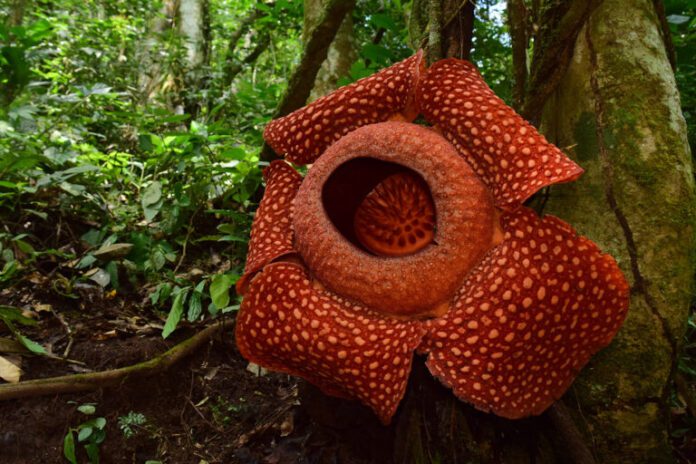- Rafflesia, flowering parasitic vegetation stumbled on easiest in Southeast Asian rainforests, are infamously advanced to glimpse attributable to their rarity and tiny habitat ranges.
- With Rafflesia species edging nearer to extinction attributable to habitat loss, botanists are working to larger notice the genus and to fabricate methods that enable the vegetation to be propagated in labs and botanical gardens.
- Parallel research efforts from two teams led by Filipino scientists are yielding promising ends in each determining how Rafflesia function on the genetic stage and in refining methods that can enable for ex situ cultivation.
Came across easiest in Southeast Asian rainforests, the Rafflesia genus produces the world’s best flora. Their prodigious dimension is now not any tiny feat, thinking about that Rafflesia relish neither roots, leaves nor stems. Moreover they’re incapable of photosynthesis, relying totally on their hosts (certain species of Tetrastigma vines) for nourishment.
These parasitic vegetation stay thought to be certainly one of botany’s best mysteries. The gaps in knowledge about Rafflesia dangle created a for breeze in depth command for conservationists scrambling to construct them, particularly inside the Philippines, which scientists grasp into consideration to be thought to be certainly one of many few facilities of Rafflesia differ.
Threats to Rafflesia conservation inside the Philippines
On account of their rarity and intensely tiny habitat differ, Rafflesia are infamously advanced to glimpse.
Consultants dangle didn’t develop Rafflesia vegetation ex situ outdoor of their host vines, says Erika Marie Bascos of the College of the Philippines Diliman’s Institute of Biology. “In contrast to nonparasitic vegetation, Rafflesia can now not be readily propagated by plan of cuttings, seeds or tissue custom,” she suggested Mongabay, including that Rafflesia dangle easiest been efficiently propagated by grafting contaminated vines or implanting seeds into uninfected hosts, methods that grasp a very very long time to yield outcomes.

In the meantime, the clock is ticking, as all Rafflesia species are inching nearer in the direction of extinction.
Habitat destruction is a severe risk, even in circumstances of tiny-scale land conversion. In step with Esperanza Maribel Agoo, a professor from the Biology Division of De La Salle College in Manila, Rafflesia on private lands endure habitat loss when homeowners convert their properties for industrial capabilities.
Even Rafflesia-centric ecotourism has created risks for the vegetation’ conservation. “On account of of us are for breeze conscious that they will generate income from displaying these vegetation to the favored public, they occasionally struggle over which property must aloof be thought-about first,” says Agoo, recalling a case of 1 household in Panay (a part of the Visayas island group) who destroyed Rafflesia on yet one more household’s land trustworthy to monopolize vacationers’ consideration.
Bascos additionally laments that ecotourism spots occasionally fail to embody scientists’ methods about exhibiting the vegetation with out demanding their pure ambiance and inflicting “extra destroy to the already scarce Rafflesia populations.”

Filling inside the methods gaps about Rafflesia
However yet one more risk to Rafflesia conservation is the favored lack of expertise and consciousness referring to the genus. “Rafflesia species are uncommon and restricted to faraway forest habitats of Southeast Asia, so that they are advanced to rep to, come by and glimpse,” evolutionary biologist Jeanmaire Molina, of Uncommon York’s Tempo College, tells Mongabay.
In a most fashionable glimpse, Molina labored with scientists from the Philippines, the US, Canada and Indonesia to assemble and glimpse a transcriptome (a sequence of gene transcripts) from the seeds of R. speciosa obtained from Miagao, Iloilo, inside the Philippines.
By inspecting Rafflesia on the molecular stage and evaluating its transcriptome to certain flowering and parasitic vegetation, Molina and her colleagues stumbled on up to date knowledge referring to the genetic and metabolic pathways of those mysterious vegetation. They recognized explicit compounds and enzymes that may toughen the possibilities of a hit seed inoculation. As nicely they stumbled on no genes pointing to a symbiotic relationship between Rafflesia and fungi, suggesting that not like orchids, Rafflesia may presumably presumably now not want nutritional vitamins from fungi for a hit germination.
“Studying biodiversity on the molecular stage, particularly with a seed, would resolution a type of concerns in propagation,” says Agoo, who’s now not affiliated with the glimpse. “Molina’s lab geared up the scientific basis for the plan Rafflesia exists and subsequently how [conservation] additionally may also be carried out ex situ [outside its natural habitats].”


Native Rafflesia ex situ propagation
In the meantime, a workforce of conservationists on the College of the Philippines Los Baños is taking a a lot easier plan. Pastor Malabrigo from the faculty’s Division of Woodland Organic Sciences turned into a part of a workforce that visited Indonesia’s Bogor Botanical Backyard in November 2022, together with educating companion Adriane Tobias and Chris Thorogood from Oxford College. There, he says, they studied methods Bogor employed to efficiently propagate R. patma ex situ. “Our Indonesian colleagues dangle experimented with diverse methods to develop R. patma for larger than twenty years,” Tobias tells Mongabay. Ultimately of their day trip, Malabrigo’s group rigorously studied the grafting methods the Bogor researchers primitive; upon their return to the Philippines, they immediately assign to work.
Malabrigo’s workforce opted to make expend of vines contaminated with R. panchoana from Mount Makiling in Luzon, shut to the grafting place on the UP Laguna Land Grant. For a hit grafts, Malabrigo says, “it is going to aloof now not grasp larger than 24 hours to move [the infected vine] from the present.” Whereas some Rafflesia grasp in to six years to bloom, R. panchoana’s duplicate cycle must aloof enable ends in merely two years.
Bascos says she believes that if Malabrigo’s workforce succeeds, they’re going to discount doable researchers overcome the challenges of gathering samples and transporting them to the laboratory, the command of conducting in situ research and the hazard of conducting research in areas the place the Philippine protection energy conducts anti-insurgency operations. “The possibility of rising and being succesful of glimpse Rafflesia in botanical gardens may presumably presumably for breeze discount enhance Rafflesia research inside the nation,” Bascos says.
“One resolution to Rafflesia propagation is producing scientific proof, whereas the numerous is completely merely doing it,” Agoo says. “Each being carried out in parallel is a trustworthy factor.”

All arms on deck
Finally, a hit Rafflesia conservation inside the Philippines relies upon now not trustworthy on research and motion from the scientific group however as well as on the dedication and involvement of policymakers and favourite voters.
“We dangle obtained to deal with the curiosity of the native of us themselves,” stresses Agoo. “Not us who’re a long way from the assign, who can accomplish experiments in our laboratories.”
“This make of information, when laymanized and shared with the favored public and authorities businesses, would for breeze result in larger insurance policies,” Bascos says. “And, confidently, extra consideration and appreciation for this unprecedented species.”
Banner picture: The Rafflesia relish neither roots, leaves nor stems. Picture by Aqil F by plan of Wikimedia Commons (CC BY-SA 4.0).
Unlawful plant change, tourism threaten up to date Philippine flowering herbs
Citations:
Bascos, E. M. A., Rodriguez, L. J. V., Duya, M. V., Fernando, E. S., & Ong, P. S. (2019). Philippine Rafflesia: Rising patterns in floral morphology and distribution. Vegetation, 257, 151409. doi:10.1016/j.flora.2019.05.008
Molina, J., Wicaksono, A., Michael, T. P., Kwak, S., Pedales, R. D., Joly‐Lopez, Z., … Purugganan, M. D. (2023). The seed transcriptome of Rafflesia exhibits horizontal gene swap and convergent evolution: Implications for conserving the world’s best flower. PLANTS, PEOPLE, PLANET. doi:10.1002/ppp3.10370
Jąkalski, M., Minasiewicz, J., Caius, J., May, M., Selosse, M., & Delannoy, E. (2021). The Genomic have an effect on of Mycoheterotrophy in orchids. Frontiers in Plant Science, 12. doi:10.3389/fpls.2021.632033

